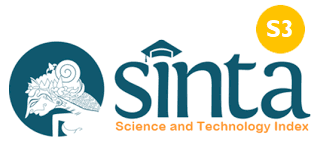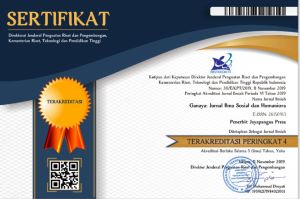Praktik Asketisme Pra Islam dan Rekonsiliasi terhadap Islamisasi di Gunung Kumbang, Brebes, Jawa Tengah (Abad XVI-XXI M)
DOI:
https://doi.org/10.37329/ganaya.v7i4.3485Keywords:
Gunung Kumbang, asceticism practice, Islamization, culture reconsilizationAbstract
Mount Kumbang, located in Ketanggungan Subdistrict, Brebes Regency, has been utilized as a site for ascetic practices since pre-Islamic times up to the present. This research aims to discuss the transition of ascetic practices due to Islamization on the slopes of Mount Kumbang from the 16th century to the present. The research focuses on the narrative of the encounter between pre-Islamic asceticism and Islamization, the forms of cultural reconciliation between pre-Islamic traditions and Islam, and how the ascetic community on Mount Kumbang has been politically portrayed in the process of Islamization. The historical method, encompassing heuristic processes, criticism, interpretation, and historiography, was employed in this research. The results demonstrate that the encounter between pre-Islamic asceticism and Islamization proceeded peacefully and was full of reconciliation. The narrative of Islamization and pre-Islamic asceticism appears in the "Babad Cirebon" and local folklore, which recount the continuation of ascetic traditions such as meditation practiced by Islamic disseminators on Mount Kumbang. Cultural reconciliation between pre-Islamic asceticism and Islamization is also evident in historical narratives, oral sources, and the culture of the community on the slopes of Mount Kumbang, such as taboos, the "ngasa" ritual, and religious practices that exhibit archaic characteristics and are well-documented in historical sources from both the colonial period and the present. The ascetic community has also politically contributed to Islamization by being portrayed as peacefully accepting Islamization, albeit not fully in its entirety. The ascetic community has been utilized as agents to depict the acceptance of Islam, even though it was not shown through perfect Islamic practices. The conclusion of this research indicates the continuity of ascetic practices from pre-Islamic traditions to Islamic traditions, as recorded in historical sources from the Islamic, colonial, and contemporary periods.
References
Adawiyah, S.R. (2022). Upacara Adat Ngasa di Kampung Budaya Jalawastu dalam Perspektif Teologis. Jurnal Riset Agama 2 (1), 200-219
Akbar, Ali. (2017). “Reconstruction Of An Indigenous Community‘S Belief In Dragon; Research On Prehistoric Batu Naga Site In Kuningan, West Jawa”. Wacana: Journal of the Humanities of Indonesia, 18(3), 614-640.
Atja. (1970). Ratu Pakuan: Tjerita Sunda Kuno dari Lereng Gunung Tjikoeray. Bandung: Lembaga Bahasa dan Sejarah
Acri, A. (2021). Dari Siwaisme Jawa ke Agama Hindu Bali: Kumpulan Tulisan Pilihan. Jakarta: Kepustakaan Populer Gramedia dan EFEO.
Darsa, U. A. (1998). Sang Hyang Hayu: Kajian Filologis Naskah Bahasa Jawa Kuno di Sunda pada Abad XVI. Bandung: Program Pascasarjana Universitas Padjadjaran.
Darsa, U. A. (2006). Sewaka Dharma: Dalam Naskah Tradisi Sunda Kuno Abad XV-XVII. Bandung: Program Pascasarjana Universitas Padjadjaran.
Darsa, U. A. (2012). Undang Ahmad Darsa. Sewaka Darma : Peti Tiga Cuburuy Garut. Bandung: Pusat Studi Sunda.
Djafar, H. (1991). Prasasti-Prasasti Dari Masa Kejaraan-Kejaraan Sunda. Seminar Nasional Sastra Dan Sejarah Pakuan Pajajaran.
Fauziyah, E. F., & Gantina, G. (2022). Naskah Tiga Ajñana: Sebuah Tinjauan Filologis: Naskah Tiga Ajñana: Sebuah Tinjauan Filologis. Kabuyutan, 1(1), 20-23.
Flood, G. (2004). The Ascetic Self: Subjectivity, Memory, and Tradition. Cambridge: Cambridge University Press.
Florida, N. K. (2022). Menyurat Yang Silam Menggurat yang Menjelang: Sejarah sebagai Nubuat di Jawa Masa Kolonial. Yogyakarta: Mata Bangsa
Herlina, N. (2020). Metode Sejarah. Bandung: Satya Historika.
Kuntowijoyo. (1995). Metodologi Sejarah. Yogyakarta: Tiara Wacana.
Kuntowijoyo. (1995). Pengantar Ilmu Sejarah. Yogyakarta: Tiara Wacana.
Misbahuddin, D. (2023). Distribusi Situs-Situs Arkeologi di Kawasan Pegunungan Kumbang-Pojoktilu-Subang: Kajian Determinan Ekologi. Depok: Fakultas Ilmu Budaya Universitas Indonesia
Mulder, Neils. (2022). Mistik, Kebatinan, dan Kehidupan Orang Jawa. Yogyakarta: Jawa Book
Munandar, A. A. (2010). Tatar Sunda Masa Silam. Jakarta: Wedatama Widya Sastra.
Munandar, A. A. (2011). Bangunan Suci Sunda Kuna. Jakarta: Wedatama Widya Sastra.
Negoro, Raden Aria Tjondro. (1884). “Beschrijving van het district Salem en in het bizonder van het gehucht Goenoeng-Segara”, dalam Tijdschrift van het Bataviaasch Genootschap van Kunsten en Wetenschappen/Tijdschrift voor Indische taal-, land-, en volkenkunde Volume XXIX. Batavia: Bruining & Co.
Noorduyn, J. (2019). Perjalanan Bujangga Manik Menyusuri Tanah Jawa: Data Topografis dari Sumber Sunda Kuno. Yogyakarta: Ombak.
Pigeaud, T. G. (1960). Java in the Fourteenth Century . The Hague: Martinus Nijhoff.
Pudjiastuti, T. (1991). Sajarah Banten: Edisi Kritik Teks. Jakarta: Program Pascasarjana Universitas Indonesia.
Ricklefs, M. C. (2006). Mystic Synthesis in Java: A History of Islamization from the Fourteenth to the early Nineteenth Centuries. Norwalk: EastBridge.
Ricklefs, M. C. (2012). Mengislamkan Jawa: Sejarah Islamisasi di Jawa dan Penentangannya dari 1930 sampai sekarang. Jakarta: Serambi.
Sedyawati, E., Pojoh, I. H. E., Rahardjo, S., & Soekmono, R. (1990). Monumen: karya persembahan untuk Prof. Dr. R. Soekmono. (No Title).
Santiko, H. (2005). Mandala (Kadewaguruan) pada Masyarakat Majapahit. In H. Santiko, Hari-Hara Kumpulan Tulisan tentang Agama Veda dan Hindu di Indonesia Abad IV-XXVI Masehi (pp. 110-125). Depok: Fakultas Ilmu Budaya Universitas Indonesia.
Saringendyanti, E. (2018). Sunda Wiwitan Di Tatar Sunda Pada Abad V - Awal XXI: Perspektif Historis-Arkeologis. Bandung: Program Pascasarjana Universitas Padjadjaran.
Sudibjo, Z. H. (1979). Babad Cirebon [naskah Klayan] : Naskah Asli milik Bapak Tarjadi Tjokrodipuro. Departemen Pendidikan dan Kebudayaan
Sunjana, D. (2019). Gunung Sebagai Lokasi Situs-Situs Keagamaan Dan Skriptoria Masa Sunda Kuno. Purbawidya: Jurnal Penelitian Dan Pengembangan Arkeologi, 8(2), 97–111., 37-52
Tricht, V. (1889). Levende Antiquitein in West Java. Batavia: Uitgave G. Kolff
Wijanarto, W. (2018). Harmoni Di Kaki Gunung Kumbang Ngasa, Komunitas Jalawastu dan Jejak Sunda di KabupatenBrebes. Aceh Anthropological Journal, 2(2), 37-54.
Downloads
Published
How to Cite
Issue
Section
License
Copyright (c) 2024 Dani Sunjana, Etty Saringendyanti, Widyo Nugrahanto (Author)

This work is licensed under a Creative Commons Attribution-ShareAlike 4.0 International License.
An author who publishes in the Ganaya : Jurnal Ilmu Sosial dan Humaniora agrees to the following terms:
- Author retains the copyright and grants the journal the right of first publication of the work simultaneously licensed under the Creative Commons Attribution-ShareAlike 4.0 License that allows others to share the work with an acknowledgement of the work's authorship and initial publication in this journal
- Author is able to enter into separate, additional contractual arrangements for the non-exclusive distribution of the journal's published version of the work (e.g., post it to an institutional repository or publish it in a book) with the acknowledgement of its initial publication in this journal.
- Author is permitted and encouraged to post his/her work online (e.g., in institutional repositories or on their website) prior to and during the submission process, as it can lead to productive exchanges, as well as earlier and greater citation of the published work (See The Effect of Open Access).
Read more about the Creative Commons Attribution-ShareAlike 4.0 Licence here: https://creativecommons.org/licenses/by-sa/4.0/.








